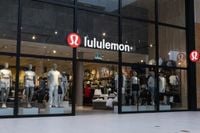Lululemon Athletica Inc. reported its fiscal first-quarter results for 2025 on June 5, revealing a mixed financial picture that has left investors cautious. The athletic apparel giant posted revenue of $2.37 billion, a 7.3% increase year over year, narrowly beating Wall Street’s expectations. Earnings per share (EPS) came in at $2.60, slightly above the anticipated $2.58. Despite these solid numbers, the company’s stock plunged approximately 20% in after-hours trading, driven by a lowered full-year earnings outlook and concerns over a challenging macroeconomic environment.
CEO Calvin McDonald acknowledged the hurdles facing Lululemon, particularly in the U.S. market. He expressed dissatisfaction with the slower growth stateside, noting that consumers are increasingly cautious and deliberate in their purchasing decisions. “We intend to leverage our strong financial position and competitive advantages to play offense, while we continue to invest in the growth opportunities in front of us,” McDonald said in a press release. However, he admitted during the earnings call that he is “not happy” with the U.S. growth trajectory, underscoring the dynamic challenges the company faces.
Financially, Lululemon’s first-quarter gross margin rose to 58.3%, ahead of analysts’ 57.7% estimate, reflecting efficient cost management despite rising pressures. Operating margin, however, declined to 18.5% from 19.6% a year earlier, illustrating some margin compression amid increased expenses. The company’s net income stood at $314 million, or $2.60 per share, compared to $321 million, or $2.54 per share, in the same quarter last year.
One significant headwind is the impact of U.S. tariffs on Lululemon’s supply chain. The company sources a substantial portion of its products from Asia, including Vietnam (40%), Cambodia (17%), Sri Lanka (11%), Indonesia (11%), and Bangladesh (7%). With the current 30% incremental tariff on China and an additional 10% levy on other sourcing countries, Lululemon faces increased costs that it plans to offset through “strategic price increases” on select items. CFO Meghan Frank explained that these modest price hikes will roll out starting in the second half of the current quarter and continue into the third quarter, aiming to mitigate tariff impacts without alienating customers.
Despite the tariff challenges, Lululemon’s international segment showed strength, with net revenue increasing 19% year over year and comparable sales up 6%. Conversely, the Americas segment saw a 3% revenue increase but a 2% decline in comparable sales, underscoring the cautious U.S. consumer environment. Overall, comparable sales rose just 1% globally, falling short of the 3% growth analysts had anticipated.
The company’s store footprint continues to expand, with 770 locations at the end of Q1 2025, up from 711 a year earlier. This growth, averaging an 8.8% annual increase over the past two years, reflects Lululemon’s strategy to capture new markets and increase accessibility. However, same-store sales growth slowed to 1% in Q1, a notable deceleration from the 6% growth seen the previous year, indicating some softness in established markets.
Looking ahead, Lululemon reaffirmed its full-year revenue guidance at approximately $11.15 billion to $11.3 billion, aligning with Wall Street’s expectations. However, the company cut its full-year EPS forecast to a range of $14.58 to $14.78, down from the prior range of $14.95 to $15.15, missing analysts’ consensus of $14.89. For the second quarter, revenue is expected between $2.535 billion and $2.56 billion, with EPS guidance of $2.85 to $2.90, both slightly below analyst estimates.
Inventory levels rose sharply, with a 23% increase to $1.7 billion compared to the same period last year, suggesting Lululemon is building stock to meet anticipated demand despite the macroeconomic uncertainties. The company ended the quarter with $1.3 billion in cash and cash equivalents, maintaining a strong liquidity position.
Market reaction was swift and severe. Shares of Lululemon dropped about 23% in extended trading immediately following the earnings announcement, reflecting investor concerns over the earnings guidance cut and the impact of tariffs. Year-to-date, the stock had already fallen approximately 13-14%, signaling broader market apprehension about the company’s near-term prospects amid economic headwinds.
Despite the setbacks, Lululemon’s long-term growth story remains intact. Over the past six years, the company achieved a remarkable 21% compounded annual growth rate in sales, driven by successful store expansion, product innovation, and brand strength. Management highlighted ongoing investments in innovation and brand activations worldwide, aiming to sustain growth momentum.
Industry peers have faced similar challenges. Retailers such as Abercrombie & Fitch, Macy’s, and American Eagle Outfitters have reduced or withdrawn guidance amid tariff concerns and economic uncertainty. Athleticwear competitors like Gap’s Athleta brand and Nike have also announced price increases to offset tariff costs. Lululemon’s approach, combining selective price hikes with continued expansion, reflects a strategic balancing act in a complex environment.
Analysts remain cautiously optimistic. According to recent consensus ratings, Lululemon holds a Moderate Buy rating, with an average price target around $345.58, implying modest upside from current levels. However, these assessments are likely to be revisited in light of the latest earnings and guidance.
In summary, Lululemon’s Q1 2025 results showcase a company navigating turbulent waters. While revenue growth and profitability narrowly beat expectations, the lowered earnings guidance and cautious consumer behavior in key markets have rattled investors. The company’s ability to manage tariff pressures, execute strategic price increases, and capitalize on international growth will be critical to its performance in the coming quarters. For now, Lululemon stands at a crossroads, balancing resilience with the realities of a dynamic macroenvironment.

